Bearded dragons are one of the best reptile pets. They grow to a modest size of about 24 inches (61 cm) or less. When properly cared for, they can live a long time with an average of 7-10 years. They are smart, friendly, and very personable. Most are very tame and can be held and petted. Following is my rendition of a Bearded Dragon care sheet for your reference.
Caring for your Pet Lizard
Bearded Dragons look equally cute wandering around your supervised living room or swimming in a partially filled bathtub. Although they do have specific care requirements, they can be a fun and relatively easy addition to the family. We hope this Bearded Dragon Care Sheet you will provide you with all that you’re looking for to keep your pet healthy and happy for years to come.
Veterinarian Exams
Finding a good reptile vet is the first thing you should do when you get your dragon. Bearded dragons can get many kinds of parasites and when left untreated can kill your pet. Taking a fecal sample is the cheapest way to solve this problem. Ask if they will check the sample without seeing the dragon first. Many Vets will do this but will not give out medications until they have seen the reptile. Finding a good reptile vet in your area is not always easy but is necessary. Check out this site for a good list of vets: Anapsid.org If you live local to us please email us for a reference to the vet we use and love.
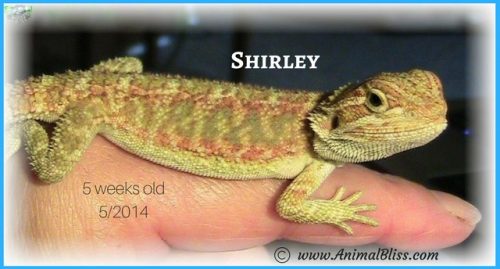
Bearded Dragon Enclosures
Baby bearded dragons can be kept in small 20 gallon long tanks. Reptile tanks are usually wider and lower in height to give the maximum floor space. Juvenile (4 months or so) and adult dragons are very active and need larger enclosures to keep them happy and healthy. Once your dragon is 10-12 inches (26-31 cm), it needs to move up to a bigger tank. The smallest size tank a juvenile or adult can be housed in is a 40-gallon breeder tank
It is best not to house more than one Bearded Dragon in a tank together. However, should you decide to, a pair should be kept in a minimum 75-gallon tank. Tank size can also vary according to the size of your dragons. A 24 inch (61 cm) male will need more space than an 18 inch (46 cm) male. The larger space you can give your bearded dragons, the happier they will be. Males and females should be kept together ONLY as babies! Once they reach the Juvenile age they should be separated. Males should live alone at this point, but females can usually live together. But watch carefully for any dominance issues or one of the dragons hiding too much. If one is doing poorly, then separating them will most likely help.
We do not recommend keeping more than two “Beardies” together.
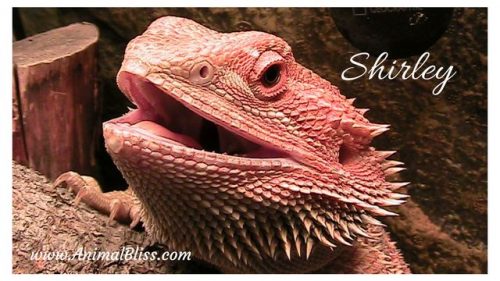
Enclosure Substrate
Any Bearded Dragon care sheet should mention using sand as a substrate. What to use on the bottom of your bearded dragon cage is a highly debated topic — namely, to use sand or not. If a Bearded Dragon picks up its food from the bottom of the tank, and you’ve laid down sand, a significant amount of sand may be digested over time. Sand collecting in the intestines could lead to impaction, sometimes proving fatal. It’s just not worth the risk.
Most substrates such as Calci-Sand, walnut shells, and lizard litter sold at pet stores can harm your pet.
As babies, your pets can live on substrate like newspaper, paper towels, outdoor carpeting, or reptile carpet, for example. It should go without saying that changing the substrate often will cut down on your dragon getting sick.
Once they have grown up to 10″ (25 cm) or so, it’s time to consider more permanent material.
I recommend ceramic or slate tiles available from home hardware stores. Go with the floor measurements of your tank and they will cut the tile for you to get a perfect fit. Look for 10×10 or 12×12 inch tile, which you can often find on sale. Tiles look very nice and they’re super easy to clean.
Enclosure Furniture
You want your beardies to be happy but try not to go overboard and crowd the cage. Furnishings take up space and so you want the furnishings to be functional. Branches large enough for the beardie to lay on are good to get your pet near his basking site. If your cage is tall, find a way to use the space up high. Beardies love to climb high. Hemp rope can be wound tightly around to make the branches easier to grip. Rocks are also excellent because they warm up from the lights. Make sure the rocks are stable and that your beardie can’t dig under them and hurt themselves.
You can also include real or artificial plants. Ponytail palms, snake plants, jade, and pothos, all seem to work well. Make sure they are free of chemicals because your beardie might eat them. Be prepared to replace them as the dragons can be hard on the plants. You do want a hiding spot for your beardie as they LOVE to hide. Half logs that are sold in pet stores work well (get a large one since they grow fast) and so do flower pots turned on their sides. Be creative. It can be a flat space.
Cleaning the Cage
You will need to scoop the feces out of the cage daily. This is where ceramic tile is nice. Simply pick up the poop with a tissue, then wipe with a damp cloth. Make a plan to clean thoroughly on a regular basis, scrubbing with 10% bleach, 90% water. Rince and dry well. Food bowls should be cleaned daily.
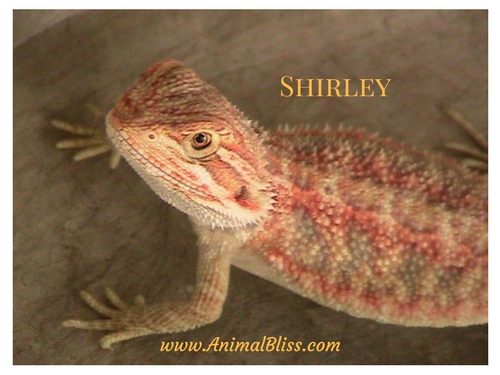
Lighting and Heating
You will need two types of lighting: UVB and heat lighting. UVB light is essential for many kinds of reptiles. The bulbs simulate the sun, allowing the dragons to produce Vitamin D3 which helps them metabolize the calcium they need to maintain health. Without UVB many reptiles get Metabolic Bone Disease (MBD). We use unique reptile fluorescent bulbs like the Reptisun 5.0 or the Reptisun 10.0. They come in different lengths. The new Reptisun 10.0 is better in tall cages as it gives off more UVB. It is also useful with a screen lid, as the screen does block out some of the UVB light. These lights need to be within 12 inches (30 cm) of the basking spot and need to be replaced every six months because the amount of UVB diminishes.
There is a new type of light called a mercury vapor light, some favorite brands being T-Rex’s Active UVHeat, Zoo Med’s Powersun, Or Mega-Ray. These combine UVB and heat in one bulb. We don’t use these bulbs, as our cages are not high enough to accommodate them. They are also very expensive and have been known to break easily. There is also some controversy whether they are safe. Research the two types and make your own decision on what is best for you.
For heating, you can use standard household bulbs, reptile basking bulbs, or standard spotlights. If you need larger than 100 watts you can find 150 and 200-watt bulbs at home improvement stores. In a taller cage, a spotlight or basking bulb is best to make sure your basking spot is warm enough. Standard light bulbs work well in cages that are low in height. Make sure the bulbs are over what will be your dragons basking spot, which should be at one end of the cage. This area needs to be between 100-110° F (38-43° C). Babies usually need a warmer spot than adults. Beardies need this heat to be able to digest their food. Use a thermometer in the cage to monitor temps or better yet, buy a non-contact temp gun and use it to check your temps frequently.
The cooler side of the tank away from the basking site should be around 75-80° F (24-27° C). At night you should not need heating unless it goes below 65 degrees (18° C). Then you can use special evening heat lights or under-tank heater attached to a thermostat on low. Without the thermostat, the under-tank heater will be really hot. Your lights should be on a cycle of about 10-14 hours on in the summer and 10-12 hours on in the winter. We prefer to keep them as close to what is happening where you are. You can regulate the lights with simple timers.
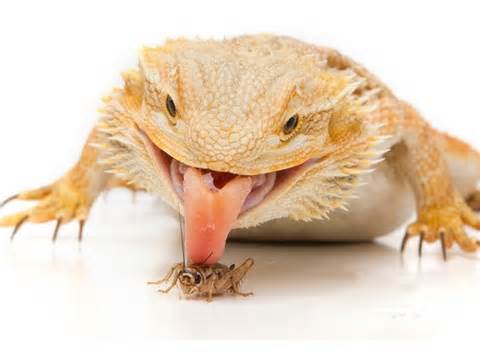
Feeding Your Bearded Dragon
Leafy greens must be offered daily. Mustard greens, collard greens, turnip greens, dandelions, escarole, chicory, and arugula can be staples in their diet. Lettuce does not have much nutritional value and should NOT make up their whole diet or even a large part. Romaine could be given occasionally if you can’t find the other greens. Spinach, kale, and swiss chard are both high in oxalic acids that bind calcium. They can be given, just not too frequently. Variety is a good idea, though. Remember, you don’t have to buy the whole huge bunch of greens. They will weigh whatever you separate out of a big bunch, which is a good way to get a wide variety without buying too many greens.
Make sure you wash all the veggies to get any pesticides off. Remove large stems (like collard stems), and any rotten parts and then rip the greens into pieces about the size of your dragons head. We cut up all our greens at once and place them in a Tupperware container lined with paper towels. This should last about a week in the fridge. Rinse the greens you are going to give to your dragon that day if you haven’t done it before. Also wetting the greens before giving them to your dragon is an excellent way to get extra water into them.
Vegetables like winter squashes, green beans, parsnips, carrots, sweet potato, and others can be grated up and added to the salad. They need to be in chopped very small or grated pieces. Dragons can not chew large chunks, and it will be hard for them to digest.
Fruits such as all the berries, mango, papaya, grapes, can be added in a small amount. Offering greens in the morning before get insects is a good way to make sure they eat their vegetables.
Bearded Dragons also eat live insects such as crickets, super worms, roaches, phoenix worms, hornworms, and silkworms. Mealworms or pinky mice should never be fed to bearded dragons
Got questions about POOP?
Visit Sarah’s Bearded Dragon Rescue for the scoop.
Water
You’ll have to decide whether or not to provide a water dish for your dragon. We find they either defecate in it or the crickets drown in it. Instead, you can spritz their greens when you feed them. You could also mist your Bearded dragon with a spray bottle daily, but be cautious with this. You don’t want too much moisture or dampness, as this could be the cause of fungal diseases in your pet.
Some dragons will drink from a spray bottle. A light spray dripped on their nose will usually run into their mouths. It’s tricky to figure out, but once you do, most dragons will drink this way.
We recommend putting them in the tub with lukewarm water on a weekly basis. Make sure they can stand easily in the water so they don’t have to swim the whole time. Watch over them the entire time they are in the water. Some beardies seem to enjoy bath time.
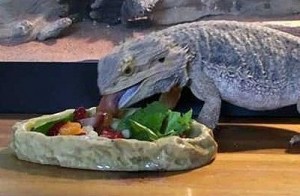
Insects
Insects should be offered to babies two or three times a day, and daily to juveniles and adults. As your bearded dragon gets older, he or she should be eating fewer insects and more vegetables than when they were juveniles Too many insects all through their life will cause kidney damage. Veggies should make up about 10-25% of hatchlings diet and 50% or more of adults diets.
You can feed your dragon as many crickets as they can eat in a 5-10 minute period. Many baby dragons will eat 25-50 crickets in a sitting.
Silkworms can be used as a staple and should be fed occasionally to beardies over 12 inches (31 cm). Mealworms and waxworms are high in fat and not recommended. We choose not to give our beardies pinky mice because of the risk of parasites from them. Also, they are high in fat, and most dragons do not need them.
Silkworms and superworms can be fed to fatten them up after hibernation and for the egg-laying females.
Never leave crickets in the cage overnight, especially with juveniles, as they can seriously hurt the baby lizards by munching on them as food. Some people choose to feed their beardies in a separate tank to avoid this. Never give babies large crickets. Never give them anything that is bigger than the space between their eyes. Hatchings eating large crickets can cause serious harm.
NEVER FEED FIREFLIES – They are TOXIC to your Bearded Dragon and will cause DEATH, often within hours!
Insect Care
We suggest buying crickets online when your dragon is young since they can eat so many crickets in a week. Take care of your crickets to get the most use of them. We use Rubbermaid tubs to house our crickets. You can cut part of the lid out and glue a piece of screen over it for ventilation. You could also use a 10-15 gallon fish tank with a screen lid. These are very cheap to buy and easy to clean. When your crickets arrive, cut one side off and quickly lower it into the container and bang on the top and shake all the crickets out. In warm weather, doing this outside is best, but with a little practice, you won’t lose any crickets. Place some of the egg crates that come with the crickets in the container for them to hide in. Add a couple of paper towel rolls also. The crickets will hide in the rolls making it easy for you to just shake them into your feeding container to dust with calcium.
RELATED: How to Care for Live Crickets, Keeping Your Crickets Alive
You need to add a gut-load product to the container to feed the crickets. You can buy this either from the cricket company or pet stores. If you run out of gut-load, you can always sprinkle in some baby cereal or cheerios, but gut-load is best. It is full of all the healthy nutrients your beardies need. The crickets eat the gut-load and then when the dragon eats the cricket, it will get all those nutrients.
You will also need to add something for them to drink. We use a potato cut up into a couple of pieces. You can also use the stalks from your greens or some orange slices. Just remove and replace if they become moldy.
Superworms can be kept the same way. We usually add an inch (3 cm) of Cheerios with the gut-load because the worms bury in it. The super worms can be kept in a flat Rubbermaid without a lid since they can’t climb the sides. They can live for a VERY long time like this. Up to two months perhaps. Silkworms are the hardest to care for, and you need to learn about them before you buy any. They are more expensive than crickets or super worms.
Supplementation for Your Bearded Dragon
Dust insects with a calcium with D3 (Rep-Cal) vitamin daily or whenever you offer live insects We put the crickets in a large yogurt container and shake them up with the vitamin dust and then serve them to the beardies. They get very excited when they see this container. About twice a week you should dust with a multivitamin instead of the calcium.
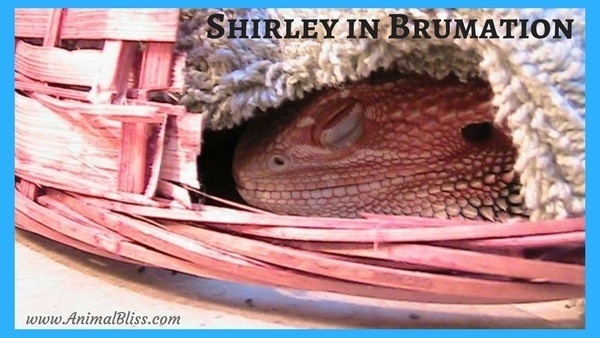
Brumation
Brumation is a form of hibernation your bearded dragon might do during his second winter. It is not a complete hibernation and is more of a semi-dormant state that your beardie might be in for the winter months. Most beardies will naturally do this, but do not force it if they do not. In many houses, the temperature will drop in the winter months, and you may notice your dragon is eating less and hiding more, which is your dragon responding to the change in season and brumating. Never brumate a sick dragon or one that has recently had parasites. They may not make it through. If you have any doubts, please see your vet for a fecal check before brumating your dragon.
If you want to be in control of your dragons brumating (important if you are going to breed them) then stop feeding him for about two weeks before the brumation begins. Give him about 2 weeks to empty out all his stomach contents and then lower the temps of the heat lights to about 85° F (30° C). Keep the lights on for only about 8-9 hours a day. Then turn off the heat lights and leave the UV lights on their cycle. We do this for a couple of weeks and then turn off the UV lights and cover their cages to keep it dark. Check them occasionally to make sure they still look healthy although they will lose weight. Two to three months later, I turn on the lights again and start feeding them. If you only have one or two dragons, just watch them and when they emerge, start the regular light and feeding cycle.
A Word of CAUTION about Salmonella:
Almost all reptiles carry Salmonella naturally. Make sure adults and children wash their hands after contact with your Bearded Dragons and make sure you don’t wash your reptile dishes with your household dishes.
~~~~~
Bearded Dragon Care Sheet | Caring for Your Pet Dragon Click To Tweet
♥
***A special shout out and “Thanks!” goes out to Felicia Prieto and her Bearded Dragon, “Harlot” for putting together this Bearded Dragon Care Sheet for us.***
Join Felicia on her Facebook group page: Crazy Bearded Dragon Lovers
♥
RELATED: Information About Bearded Dragons, Pagona Genus
- Mindful Travel With Your Dog This Holiday Season - December 23, 2019
- A-Z of Australia’s Endangered Wildlife - December 20, 2019
- Teaching Your Kids How to Walk the Dog Safely - December 2, 2019

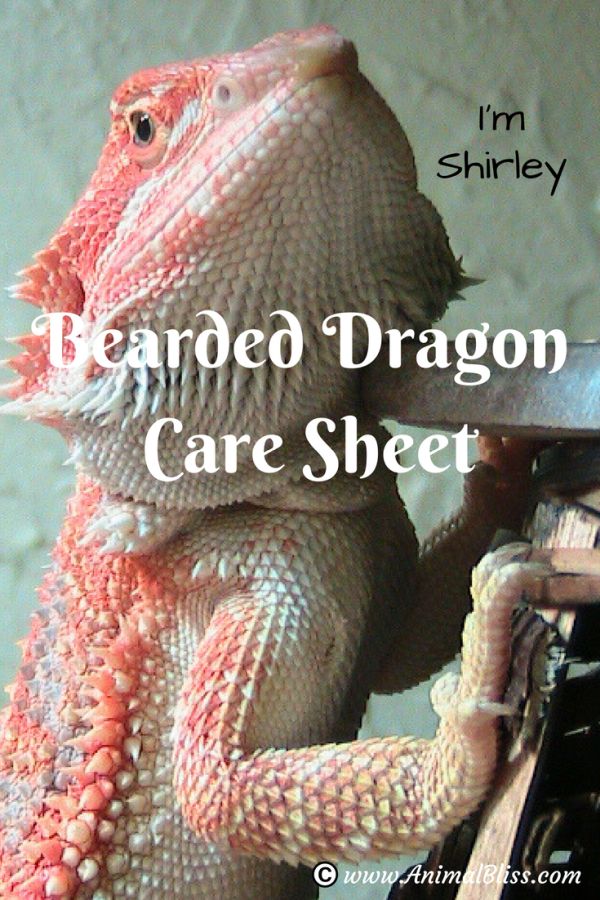
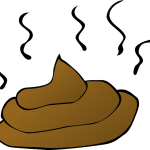
I’ve never seen a dragon with Shirley’s colors! What kind is she
She’s a Pagona Genus. I don’t think her colors are common. When she’s been in the sun for awhile she’s a pretty orange/pink color. Thanks for visiting Animal Bliss. Peace
Jeanne, I like what you mention about finding a good reptile veterinarian when you first get a bearded dragon. I think this could be a good. I want to make sure the dragon will always have the care it needs. I’ll have to keep this in mind when looking to get my son one of these. Thanks for the post!
I’ve always thought bearded dragons looked so cool. I don’t know that I’ll ever be able to have a reptile of my own, but I enjoyed reading about them!
Jessica, I’m glad you at least like reptiles. I think they’re cool-looking too. Shirley, my Bearded Dragon is my first lizard, and I’m so glad I decided to get her. She’s been a nice education for me. 🙂 Thanks for stopping by!
I had no idea their care was so involved and that fireflies were toxic to them. I was just talking about them yesterday and how they’re prone to parasites!
Yes, a firefly can kill bearded dragons in a matter of hours. Strange isn’t it? A little thing such as that? As for parasites, I’ve had Shirley for 2 years and haven’t had parasites yet. Knock on wood. Thanks for stopping by!
Very helpful article. I know some about a lot of animals but feel like I would have no clue when it comes to reptiles. I had a gecko for a short while when I was a kid but he died. We probably didn’t take care of him the right way.
Jessica, thanks for your reply. Yes, reptile care is so different from most furry pets. Especially ones that come from a dessert, like Shirley does. (Her ancestors came from Australia.) It’s a whole different ball game. Too bad about your gecko. Talk later!
Bearded Dragons have been on the rise in popularity as pets because of their docile demeanor and people friendly personalities. What is often not talked too much about by the pet stores is how much work goes into taking care of these reptiles. Before going out and buying one of these cute hatchlings it is a good idea to do some research on what it takes to care for a bearded dragon.
Oh course, it’s necessary to do your research first before getting any animals. There are far too many pets that get abandoned once reality sets in. Thanks for your comment!
I had one for 6 months sadly he passed. When i got they said he was about a month. Got at petsmart. Lost in dec. I just finally got another april 18 sat 2015. They arent sure how old they have had it there about 2 weeks Its a lil bigger than mine was he didnt fit as well in container they put them in when you bring them home
I hope this will one have better luck, Jolien. If it’s bigger, maybe it’s a little older, and will have a better chance of surviving. Take good care of it please. Thank you for your visit. Peace.
Thank you! I was heart broken. My pets are my children. I am hoping so to. Vet said other got yellow fungus from another reptile. He was the only in house. Looked healthy when bought. Didn’t show till closer till i lost. And yes did everything to save.
All the very best to you and your dragon, Jolien. 😉
Hi Jeanne ,
very interesting to read about this Lizards ,
I like them and they look really cute .
thank you
I’d love to be a bearded dragon in your home. Great info for anyone wanting one of these unique animals!
Helpful share Felicia 😉 Awesome breakdown, and like Kelli, it’s neat to learn more about lizards, as we see so many daily. Thanks!
Hi Jeanne –
Learned a few cool things here about the bearded dragon! I think their pretty darn cool. So, when are you getting yours? Lol.